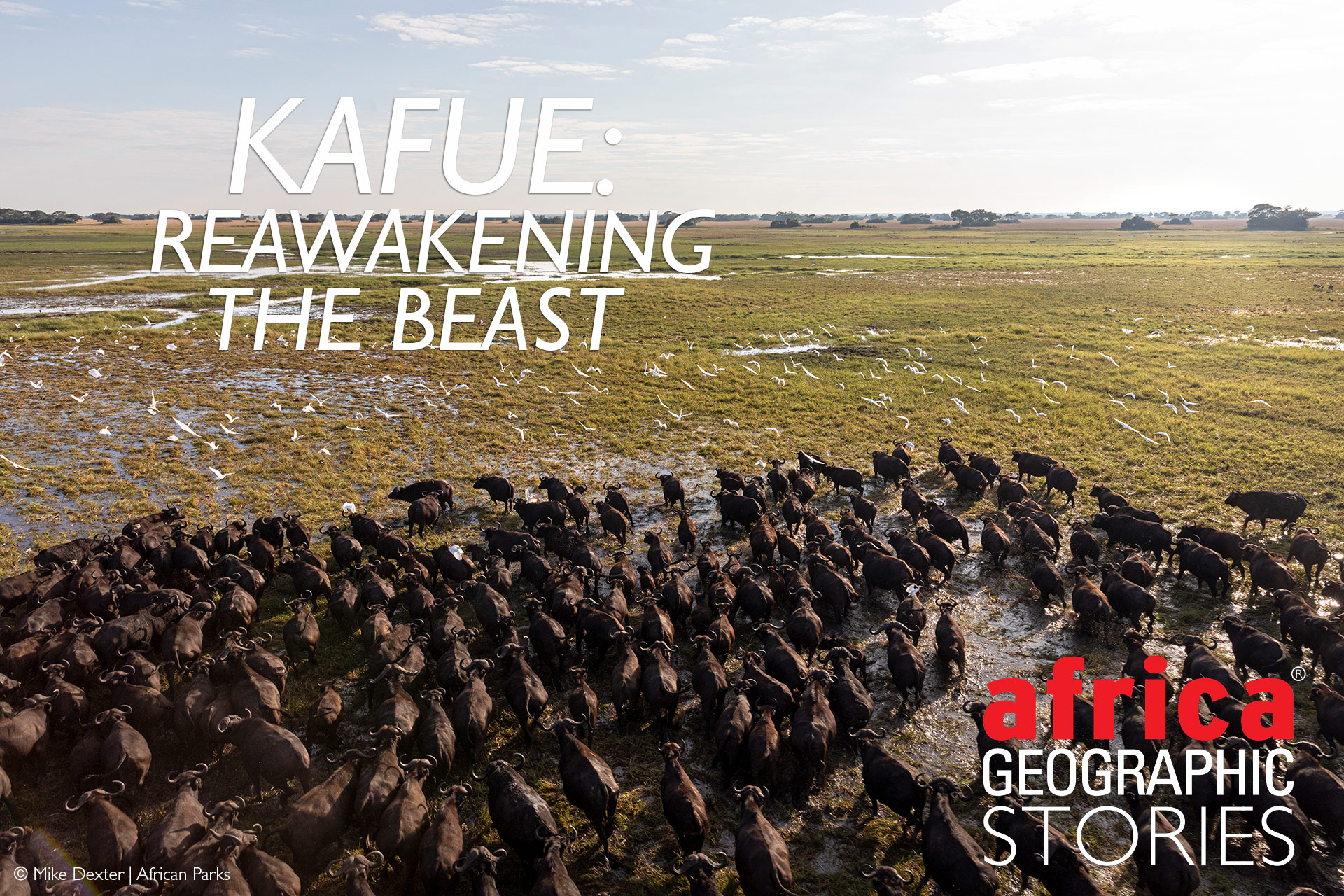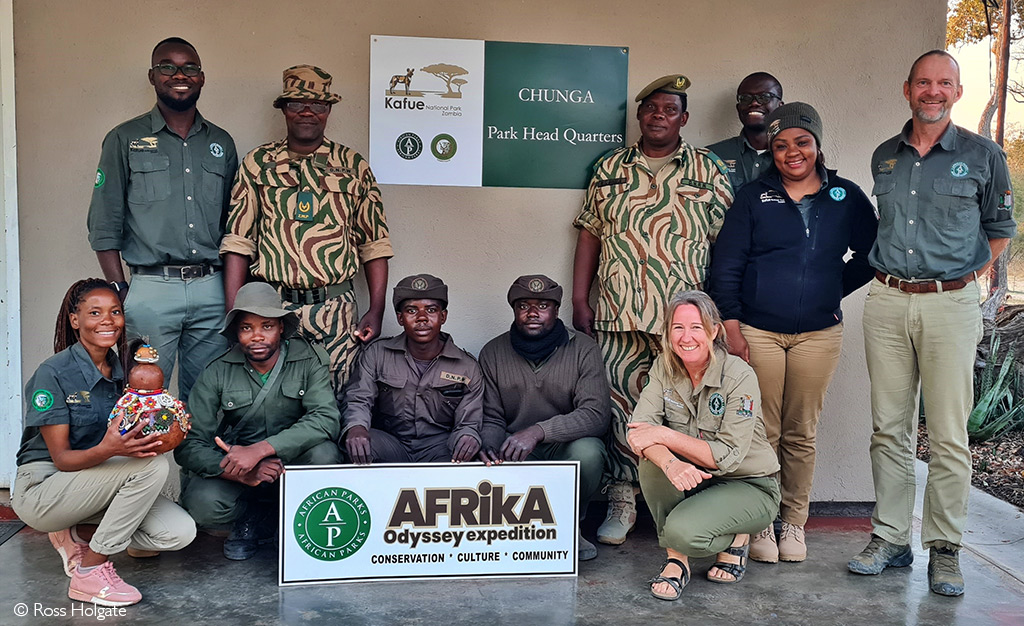
KINGSLEY HOLGATE'S AFRIKA ODYSSEY EXPEDITION


Many of you will know that funny old saying: ‘How do you eat an elephant?’ Answer: One bite at a time. Nowhere is that more accurate when weighing up the monumental work going into restoring Kafue National Park in the heart of Zambia – and it’s only just begun. Sheelagh Antrobus shares news from the road.
Renowned African explorer Kingsley Holgate and his expedition team from the Kingsley Holgate Foundation recently set off on the Afrika Odyssey expedition – an 18-month journey through 12 African countries to connect 22 national parks managed by African Parks. The expedition’s journey of purpose is to raise awareness about conservation, highlight the importance of national parks and the work done by African Parks, and provide support to local communities. Follow the journey: see stories and more info from the Afrika Odyssey expedition here.

Journey to Kafue
In Mongu, we fuel the big Defender 130s, resupply the grub-boxes and head east. It was some time ago that we last travelled this road. We’re stunned by the explosion of people, potholes and extraction out of the miombo woodlands: battered old trucks loading hundreds of big plastic-and-twine bags from endless charcoal stations, the air thick with smoke from charcoal kilns and massive piles of indigenous wood stacked on the roadside awaiting collection. It’s an incredibly distressing scene. Zambia is known to have one of the highest deforestation rates in the world, caused by many issues, and this region is one of the worst affected.

200km later, it’s a relief to cross an invisible line into Kafue National Park. Suddenly, the trees and grasslands reappear, and the air clears, and we’re reminded why these wildlife areas are so important and must be protected. As night falls, we reach the park’s Chunga HQ and, somewhat exhausted from pothole-dodging, set up a basecamp on the banks of the beautiful Kafue River.

There to meet us are park manager Craig Reid and his wife Andrea. Such kindred spirits – theirs is an exciting story to tell: born and bred in KwaZulu-Natal, South Africa, they started their conservation lives in Hluhluwe-Imfolozi Park, then set their sights on broader horizons and joined African Parks, beginning at Liuwa Plain in 2007 (it was Craig who reintroduced the lions and ended Lady Liuwa’s lonely existence). “That was before the tarred road from Mongu to Kalabo existed,” laughs Andrea. “I will never forget the long riverboat journeys we had to make across the Barotse floodplain to get supplies from Mongu – not easy when you’ve got two small children in tow!”
In 2010, they moved to Bangweulu Wetlands, spending four years in that remote northwest corner of Zambia, before moving to Liwonde National Park in Malawi 2015, African Parks’ newest management project. As we’ll soon be visiting both on this Afrika Odyssey expedition, we’re fascinated by their anecdotes of life in these vastly different wild regions, leading them to their greatest challenge yet.
The following day, Craig leads us into the park’s newly built Ops Centre – a double-storey, tennis court-sized building that hums with energy and intelligent technology. In one corner stands a display of confiscated poaching paraphernalia: wire snares, pangas, bicycles, axes, saws and firearms. “It’s there to remind us of the challenges we face daily. But I never thought I’d see the day we’d be managing parks from computer screens,” he remarks wryly, pointing to a vast, wall-mounted monitor that’s manned 24/7 and uses the EarthRanger programme to track wildlife and human movements throughout the expanse of the park. “It’s a game-changer and one we can’t do without if we’re going to restore Kafue.”


The beast that is Kafue
Craig outlines the problems that have beset Kafue over the years and the staggering amount of work now facing his newly formed 425-strong staff team. Like the size of Kafue, it’s challenging to comprehend.
“Kafue is a beast of a park,” he begins. “Proclaimed in 1950, it is Zambia’s oldest national park. At 2.4 million hectares, it is 500,000 hectares bigger than South Africa’s Kruger National Park. Suppose you include the nine Game Management Areas bordering the park. In that case, that’s almost 7 million hectares – and this greater Kafue ecosystem makes up 25% of the world’s largest transboundary conservation area, the Kavango-Zambezi TFCA, which stretches between Zambia, Angola and Namibia.”
It is massive. We’d felt the extent of it in 2015, when we’d travelled the entire length of the Park from the old railway line, sheds and steam engines at Mulubezi in the south to the Busanga Plains in the north, as part of an expedition to find the geographic centre of Africa deep in the rainforests of the Congo.
But for decades, Kafue existed in quiet despair as lack of funding and effective management allowed poaching and deforestation to take their toll on both landscape and wildlife. “When I flew over it for the first time, I couldn’t believe the well-worn bicycle tracks crisscrossing the park like highways, bringing supplies to established poaching and logging camps and carrying out bushmeat, charcoal and felled timber. It was an industrial-scale industry of destruction, much of it linked to illegal syndicates that stretch far beyond Zambia’s borders,” Craig says quietly, gazing at the floor-to-ceiling map of this national park that’s the size of Wales.
Our expedition team is, for once, at a loss for words. After a long silence, Ross asks, “How do you begin to fix this – at this scale?” It’s like a light going on. Craig grins, and our education into the work to reawaken this extraordinary ‘beast’ unfolds.


An exceptional tourist destination
“Fortunately,” Craig tells us, “huge tracts of Kafue’s wilderness still exist and, whilst heavily diminished, numbers of wildlife remain, including elephant, lion, leopard, wild dog and cheetah, the highest diversity of antelope species in Africa and over 500 bird species. There’s plenty to build on, and we also need to ensure that the Kafue River catchment area is protected. It is Lusaka’s water supply and an important ecosystem for various fish and amphibious species. Kafue has the potential to become an exceptional tourism destination in the next five to ten years and provide employment and long-term benefits to thousands of local people.”

Much has already been done since 2021 when the Zambian government invited African Parks to help resurrect Kafue National Park: over 2,000km roads graded, bridges repaired, water and power restored, aircraft hangers built, park offices and staff quarters revamped, and the state-of-the-art law enforcement centre constructed. Hundreds of jobs have been created, the park’s rangers and law enforcement teams intensively retrained, and a community education programme established.
 DID YOU KNOW that African Parks offers safari camps (lodges and campsites) where 100% of tourism revenue goes to conservation and local communities? Find out more and book your African Parks safari.
DID YOU KNOW that African Parks offers safari camps (lodges and campsites) where 100% of tourism revenue goes to conservation and local communities? Find out more and book your African Parks safari.
Thanks to the strong partnership between Zambia’s Department of National Parks and Wildlife and African Parks, poaching and deforestation are on the decline, wildlife monitoring is back in place, plans are afoot to bring in thousands of wildebeest, zebra and buffalo to restore their numbers and there’s a long-term goal to reintroduce black rhino. There’s still a monumental amount of work to do; even so, we’re struck by the resolve and confidence of everyone we meet that Kafue NP will, in time, be restored to its former glory.
We spend a few action-packed days with the park’s community teams and a cheerful bunch of Stellenbosch university students (friends of Craig and Andrea’s children) who get fully involved in a vibrant conservation education day at the Chungu Primary School. We participate in a malaria-prevention programme at the park’s clinic, and in providing eye tests and reading glasses for elderly community residents. More pages in the Scroll are filled with positive messages of hope for conservation. Peter Indala (Department of National Parks and Wildlife Area Warden) is given the honour of adding symbolic Kafue River water to the expedition’s calabash.




Our evening campfires are jolly affairs, shared with some colourful characters: bush pilots, field operations managers, scientists, staff from AP’s Zambia office and community workers. All confirm that Craig, with his vast experience and quiet, determined manner, is the right man to lead the reawakening of this beast – and everyone agrees it’s just in the nick of time.
Bidding farewell to the Kafue HQ team, we head south to Lake Itezhi Tezhi – elephant, hippo and herds of puku, zebra, and impala graze peacefully on the shoreline. At Konkomoya Lodge, we’re greeted like long-lost friends by Andrea Porro and Catarina, a colourful Italian couple who’ve heard about our wildlife odyssey and insist on treating us to a great food and hospitality night. Andrea fell in love with Kafue 17 years ago and decided to leave his life as a graphic artist and photographer in Italy to rebuild Konkomoya into a wood-and-canvas place of beauty. He handcrafted much of the furnishings himself, and the walls are filled with his spectacular photographs of Kafue’s wildlife.
 Considering Kafue for your next African safari? Check out our ready-made safari to Kafue here. Alternatively, see our other safaris here.
Considering Kafue for your next African safari? Check out our ready-made safari to Kafue here. Alternatively, see our other safaris here.
Andrea tells us he’s an artist, not a scientist. “I can’t give you the actual increase in game numbers, but something has happened here in the short time since African Parks took over the management of Kafue. You can see it in the behaviour of the wildlife; they’re calmer and seem to know they’re safe now. Even the leopards seem more chilled and unafraid – look at this.” He shows us a video clip of a leopard walking casually into the lodge’s dining area one evening, jumping onto the coffee table and sniffing at the wooden sculpture of a leopard beautifully handcrafted from small pieces of mopane by Pam Carr, daughter of Zambia’s legendary conservationist Norman Carr, who was Kafue’s Park Warden in the 50s.
We’d love to stay longer, but the Zen of Travel is calling; it’s time to point the two expeditions Defenders north – the next stop is the Bangweulu Wetlands. Thanks to all involved, this expedition to link all 22 African Parks-managed conservation areas across the continent is turning into a fascinating journey of purpose.
To comment on this story: Login (or sign up) to our app here - it's a troll-free safe place 🙂.![]()






